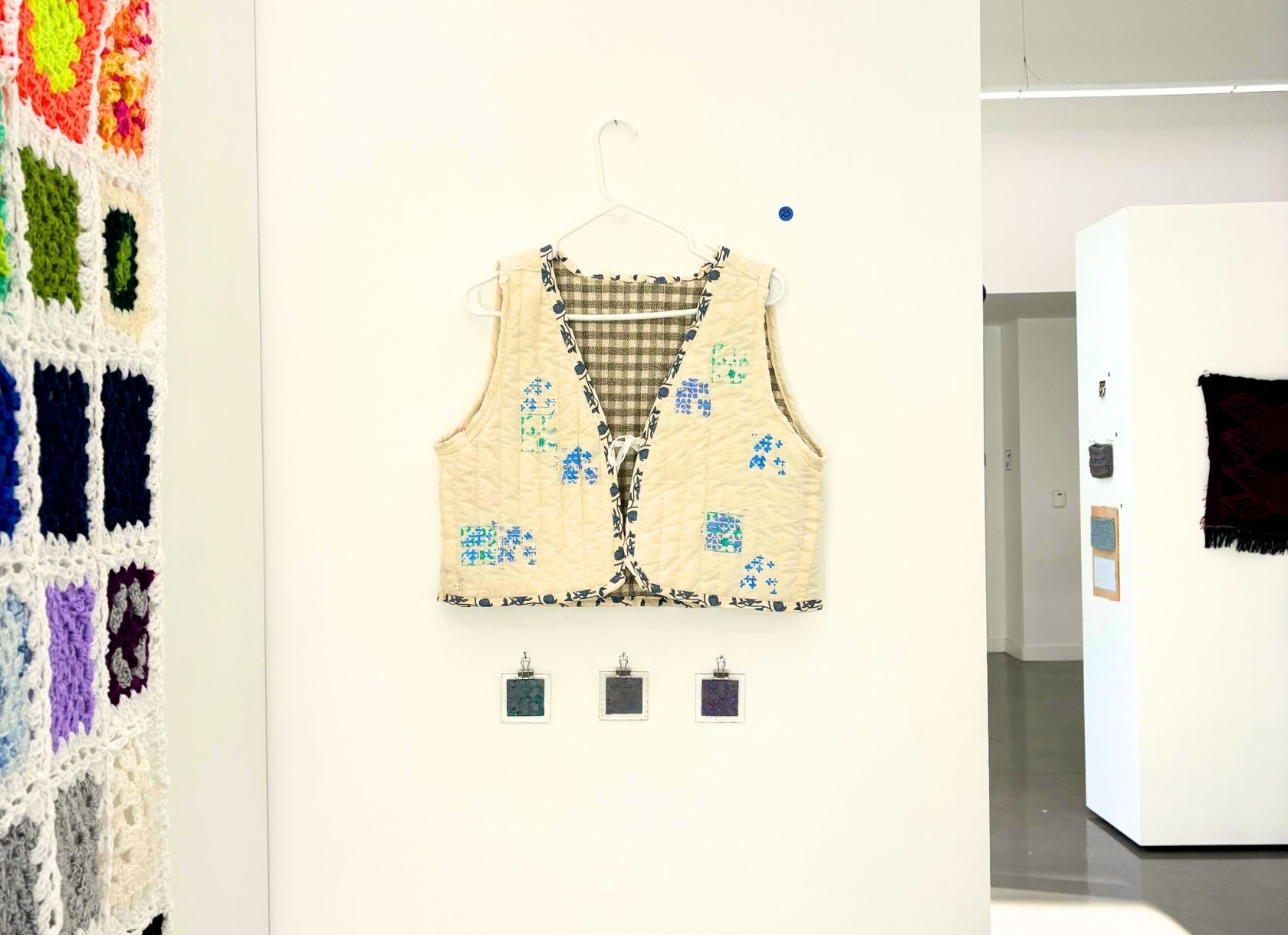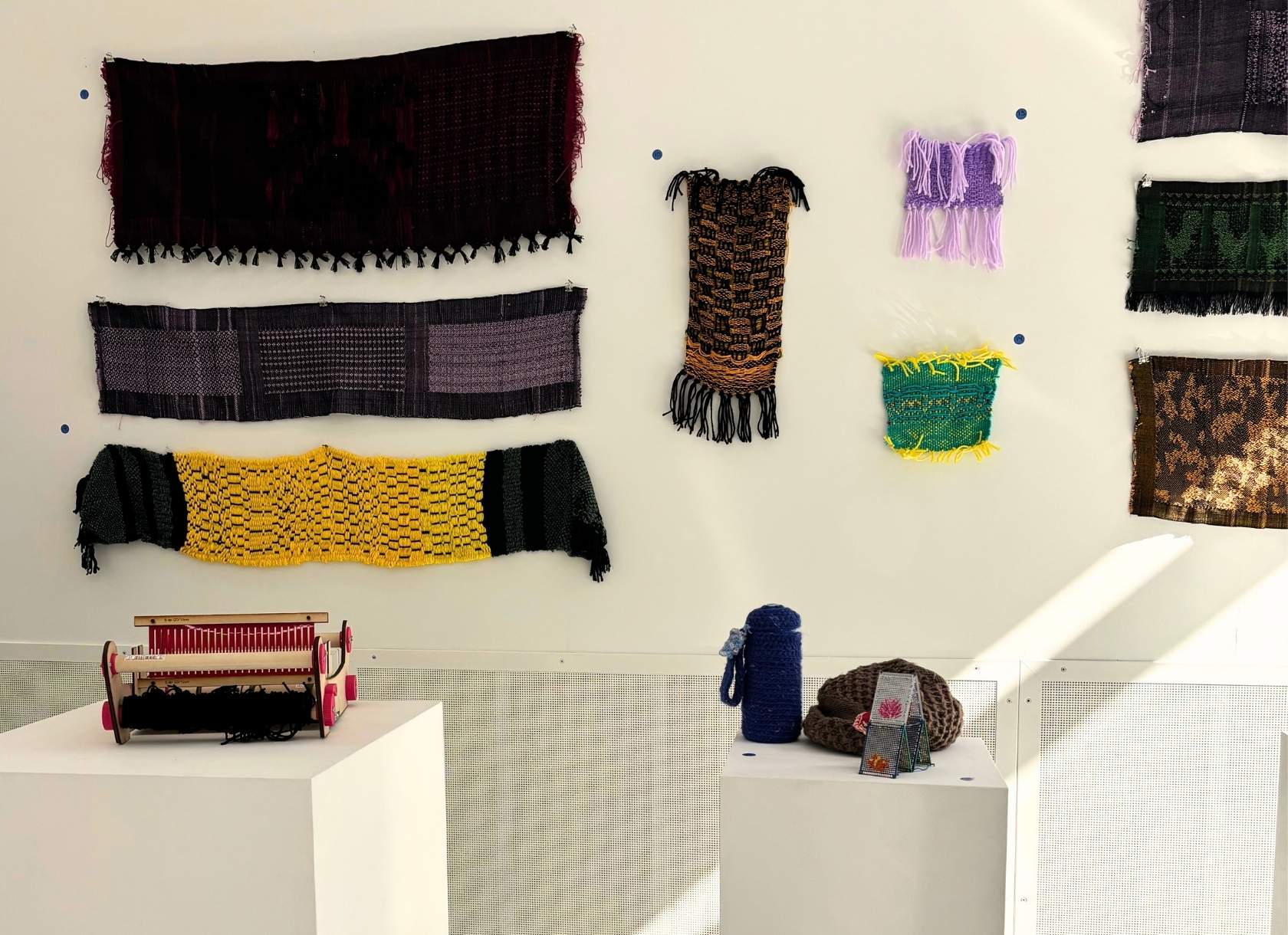
Artcrafts from students in the 5C course Making Computer Science
By Tess Miller ‘27
At Sprague Gallery at Harvey Mudd College, the sunlight makes its way through the windows onto beautifully crafted art pieces made by students from Making Computer Science, a fall 2024 5C class that included Scripps students. Associate Professor of Computer Science Julie Medero co-led the course with Adjunct Professor Casey Baden, a visual artist specializing in textiles and painting.
In line with a liberal arts college’s goal to provide a well-rounded, interdisciplinary education, the class aimed to give students different ways to apply their vast knowledge, whether it be in computer science, textiles, programming, engineering, history, English, or beyond.
“After Professor Medero and I were introduced, it seemed we would be able to work well together and decided to go for it,” says Baden. “We took what she had learned from the first iteration of the class, combined it with my skills and textile knowledge, and adapted for a larger class size.”
Making Computer Science not only combined two different fields, but it also brought people of different majors together. In class, notes Medero, students benefited from seeing instructors from very different disciplinary backgrounds learn from each other and find similarities in their work.
“Interdisciplinary courses ask the student to really take in the material, consider it deeply, and apply it to something unexpected,” Baden adds. “They can be more haptic, force a slower, more focused kind of learning, and be more impactful.”
The science of creating: Blending STEM concepts with artistic techniques
Although textiles and computer science seem like vastly different areas of study, their historical and philosophical crossovers are surprising. Medero notes that the class was inspired largely by the importance of a special tool in the history of computer science: “It turns out that the punch cards that were used by early computers were inspired by the jacquard loom, which used similar cards to ‘encode’ weaving designs,” she says.

Students blended practical computer science skills with textile techniques to complete a series of course projects
“Sewing and weaving are a part of my professional art practice, so I wanted to focus on these techniques,” notes Baden. “This class blended the real and the virtual, the analog and the digital, and the left and right brain with math, science and creativity.”
Students completed four major projects: soft circuits, which combined sewing and embroidery with circuitry and coding; weaving as code, tools, and software; smaller works involving knitting, crocheting, and soldering; and a final project where students could decide what combined skills they wanted to use. Sprague Gallery served as an exhibition space so the entire Claremont Colleges community could explore the class’s handiwork.
Interdisciplinary courses ask the student to really take in the material, consider it deeply, and apply it to something unexpected.
“Ultimately, students gained familiarity with computer science topics, used their hands to make tangible things, and cultivated creativity as a serious tool beyond a hobby level,” says Baden.
Ambika Tiwari ’25, a mathematics and computer science major at Scripps, served as the Making Computer Science teaching assistant for the last two years.
“I had been working in the Makerspace at Harvey Mudd College (an 8,000 square-foot facility for student projects) since spring 2022 and I study computer science,” she says. “I was immediately drawn to working with a class that combined both interests.”
Tiwari highlights the value of combining sciences and the arts through her role in the classroom, helping students ideate and define goals, develop a plan to build their project, train them on the necessary machines, and help them debug during the building process.
“Combining software with hands-on-making naturally compelled the students to think artistically,” she says. “We worked on understanding why their project and motivations were interesting and what they could learn from the process of building their project rather than only evaluating the final product.”
The crossover of science and arts also sparked revelations beyond the course at hand. “Making Computer Science inspired my work in classes such as Making Mathematics, Computational Photography, Machine Learning for Artists, and Human-Centered Design,” Tiwari shares.
For Medero, interdisciplinary classes like this are unique to a liberal arts education at The Claremont Colleges, helping students bridge the gaps between two fields. In these spaces, students from across the 5Cs can advance knowledge, find their passions, and learn from one another regardless of their respective majors.
“Claremont students are so helpful, kind, and generous with one another. It’s always a joy to see how they support each other,” she says. “We hope students gained applicable computer science skills, a willingness to try new things, and a celebration of the learning that happens when you attempt something and it doesn’t work out—at least at first!”

